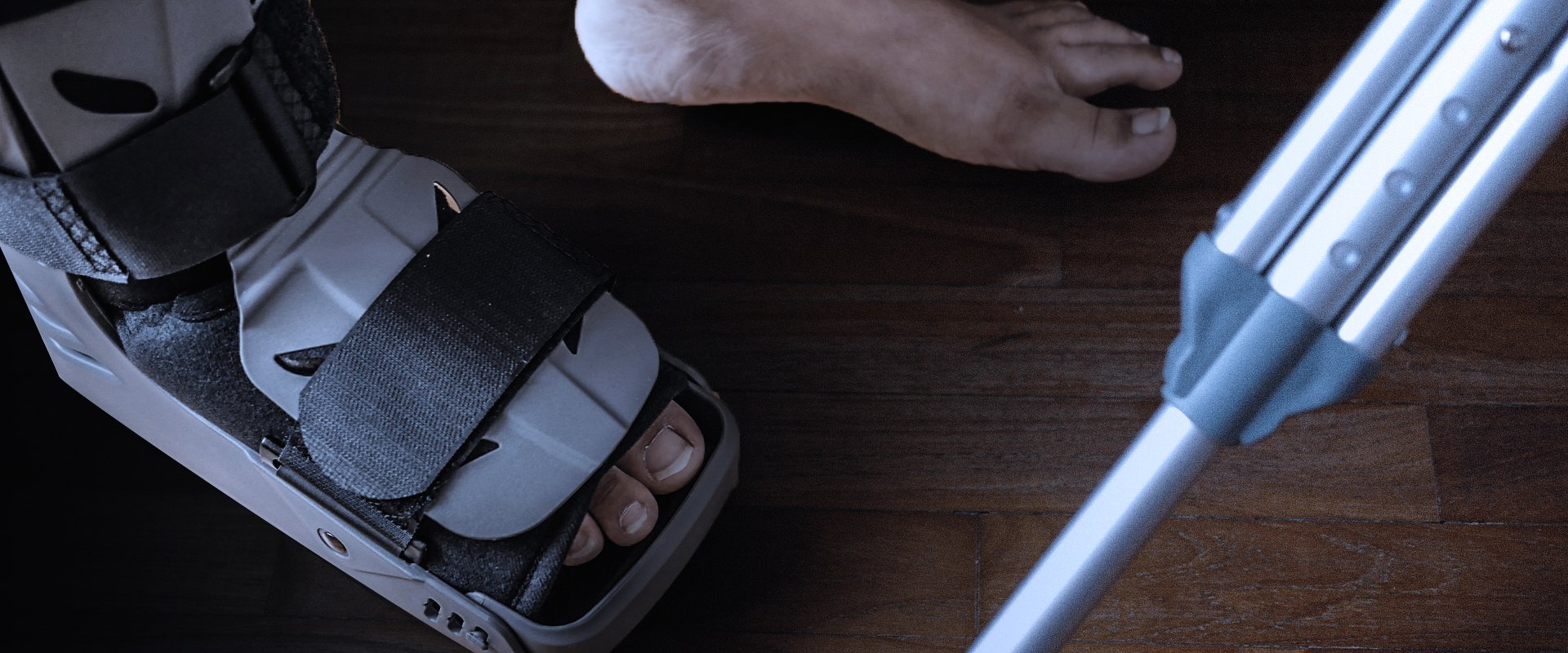
Physical Therapy for a Broken Ankle
AT EVOLVE
Physical Therapy for a Broken Ankle
HOW CAN PHYSICAL THERAPY HELP TREAT A BROKEN ANKLE?
A broken or fractured ankle can put a damper on your plans for a while but with proper care and good rehabilitation, typically has a good outcome. Physical therapy is a great tool to help recover from any broken bone and a broken ankle is no different. The role of physical therapy is different in the early and later stages of recovery but is an excellent choice to help you recover fully from the fracture and return to your prior level of function.
WHAT DOES PHYSICAL THERAPY FOR A BROKEN ANKLE LOOK LIKE?
In the early stages of recovery from a broken ankle, my team of physical therapists will focus on addressing adjacent areas, protecting the healing bone and helping you learn how to perform tasks while wearing a boot or cast or using a walker or crutches. Once the bone has healed, your PT will direct their attention to the ankle area itself in order to address any changes in strength, range of motion and flexibility that may have occurred and to help you return to your prior level of walking, running, jumping and so forth.
HOW LONG WILL I NEED ANKLE PHYSICAL THERAPY?
Most fractures heal on their own within 8 weeks. The healing time is different if the bones are stabilized surgically but rehabilitation is still an important component of recovery in those cases. While the bone is still healing, physical therapy interventions will focus on adjacent areas. Once healed, your physical therapist may recommend 4-8 weeks of rehabilitation to help restore normal function to the previously broken ankle and surrounding areas. Once PT can target the previously fractured area, you should experience improvements in many symptoms such as pain and stiffness within a couple of weeks but returns in strength, flexibility and overall mobility and return to your prior level of activity may take longer. Achieving long lasting results may take some time, but dedication to your program will help you achieve these results more quickly.
BASICS ON BROKEN BONES
Broken bones, also known as fractured bones, occur when stress across the bone exceeds the bone’s tensile strength. A bone may fracture due to trauma, or in the case of a weakened bone, can occur due to relatively normal forces. Fractures can occur in different patterns. They can be stable and nondisplaced and treated with a cast, boot or splint or unstable or displaced and treated with either closed or surgical reduction followed by a splint, cast or boot. A bone that is broken in several places or unlikely to heal well on its own often requires surgery to stabilize the fracture with some type of hardware.
Bone fractures heal in three phases. The first phase is the inflammatory phase which starts within hours of the break and is normally complete within a number of days. During this phase the body lays down a fragile matrix of new tissues to begin repairing the broken bone. During the next several weeks the reparative phase occurs in which a soft callus is initially formed by bone-producing cells and then transformed into a hard callus over time. The soft callus can easily be disrupted if the bone is not protected but the hard callus is much more durable. In the final stage, the remodeling stage, the callus is slowly removed and the bone is reshaped and smoothed out as it responds to the stress and activity placed on it by normal activity. This phase takes months to years to be completed but in most cases a fracture is considered healed in about 8 weeks.
The ankle refers to the lower part of the leg where it meets the foot. Three bones articulate to form the ankle joint. The tibia is commonly referred to as the “shin bone” and is the larger, weight bearing bone of the lower leg. The fibula is the thinner bone located on the outside of the lower leg. These two bones run parallel to one another and connect at the top and bottom of the lower leg. At the ankle, the tibia and fibula articulate with the talus bone of the foot. Together the tibia, fibula and talus form a hinge joint that allows you to flex and extend the foot.
A fracture can occur in any of these bones but when a person “breaks their ankle,” they are typically referring to a fracture in the lower part of the tibia and fibula, near the medial and lateral malleoli, the bony protuberances at the end of each bone. Signs and symptoms of a broken bone include:
- Pain, tenderness and swelling over one of the ankle bones
- Redness and bruising
- Difficulty walking on or moving the ankle
A closed and stable fracture of the ankle is typically treated conservatively with a walking boot or cast. If the fracture occurs on the tibia-side of the ankle a period of non-weight bearing may be prescribed whereas a stable fracture of the fibula may tolerate walking in a boot while it heals. If the fracture is more severe or at risk of healing poorly, surgery may be needed to stabilize the fracture. Call to Schedule a Consultation! 1-718-258-3300
End Injury Progression
Physical therapy for a broken ankle has proven to prevent injury, slow and even stop pain issues, improve performance, and reverse injury progression in many cases.
Relieve Pain
The movements used in this technique can target your entire body helping you to manage discomfort and pain during the course of your physical therapy treatments.
Improve Range of Motion
Posture awareness is an important area to focus on due to the fact that certain positions may cause you further discomfort and pain.
Restore Mobility
You can regain mobility and flexibility by taking part in the stretches and exercises as prescribed by your physical therapist.
How Long Will Physical Therapy for a Broken Ankle Last?
If you decide to work with a physical therapist to help with ankle surgery related issues, your entire treatment plan could consist of around 8-20+ different physical therapy sessions that will each last 60-90 minutes. Once you complete your customized physical therapy treatment plan, you will be able to continue to do the prescribed stretches and exercises utilized during your PT sessions yet in the comfort of your own home.
Looking for the cause of an injury
Your PT will avoid manipulating or stressing the broken ankle until the fracture is healed in order to prevent disruption of the healing bone. During this time, your physical therapist may recommend the following interventions:
- Strength training, stretching and range of motion of adjacent areas of the leg to prevent stiffness and atrophy while the ankle is healing
- Modalities to manage pain and promote healing
- Training on the use of crutches, cane or walker to offload the ankle when it is painful or healing
- Education on the healing process of bones
- Stretching, joint mobilization and range of motion to improve the flexibility and mobility of the ankle, foot and surrounding areas
- Soft tissue mobilization to address any adhesions or scar tissue in the area
- Strengthening of the toes, foot, ankle and knee to help normalize walking and prepare the ankle for return to unrestricted activity
- Balance and gait training
- Sport and work specific training to help the injured ankle and affected leg return to higher impact activities like running, jumping, stair climbing and walking on uneven terrain.
Mill Basin (located in Harbor Fitness)
6161 Strickland Ave
Brooklyn, NY 11234
Monday: 7am-8pm
Tuesday: 7am-8pm
Wednesday: 8am-5pm
Thursday: 7am-8pm
Friday: 8am-1pm
Park Slope (located in Harbor Fitness)
550 5th Ave.
Brooklyn, NY 11215
Monday: 9am-8pm
Tuesday: 8am-6pm
Wednesday: 9am-8pm
Thursday: 8am-6pm
Friday: 8am-3pm
Gravesend
372 Avenue U
Brooklyn, NY 11223
Monday-Thursday: 8am-8pm
Friday: 8am-3pm
Ready to take the next step to a healthier you?
Contact Us Today!
PHYSICAL THERAPY FOR A BROKEN ANKLE!
Need physical therapy for a fractured or broken ankle?
Let our caring and compassionate physical therapists help you with relieving pain while getting you back on your feet comfortably.
Call now to schedule your first PT consultation free of charge.
Call: 1-718-258-3300







